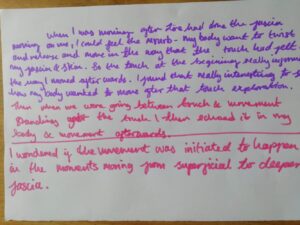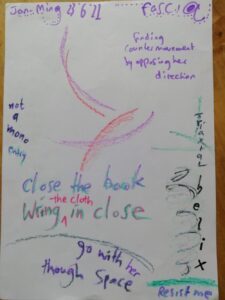Group rehearsal – week 5
- by Marie
- in research fascia
- posted June 25, 2021
23/06/2021 Zoë, Jan-Ming, Tara and Helena
Today we worked again with touch at the level of the superficial and deep fascia.
Some contact improvisers such as Ray Chung or Joerg Hassmann have used similar exercises to access the superficial fascial layer underneath the skin and have called this awareness of the fascia ‘swimming in your skin’, ‘floating on the gel’ (http://www.ecologicalbodying.com/wp-content/uploads/2020/01/moving-and-thinking-with-fascia.pdf), or ‘following with a delay’ (https://www.joerghassmann.com/somatics/fascination-fascia-why-do-i-jump-on-the-fascia-hype/).
I have used this approach in a similar way, finding the sticky point between two movers in skin to skin contact, and feeling the gliding under the skin, happening at the level of fascia.
In my solo research I have been using the floor as a point of contact and was able to tune into the visco-elastic and fluidic quality of the fascia. Feeling the continuity of fascia through the fluidic system. (https://mariechabert.com/research/rehearsal-8-strolling-under-the-skin-elasticity-sliding-inner-sleeves/)
As far as I have experienced it in Contact Improvisation, the ‘swimming in your skin’ exercise has mainly been used to differentiate the layers of reading someone else’s body: from skin to fascia to muscle to bone.
Today we made the difference with the deeper layer of fascia involved in massage therapy and soft tissue release. By sinking deeper into the muscle, applying slow sinking shearing forces that create a stretch or a pull within the fascia.
Zoë mentioned that we are probably dealing with the epimysium that surrounds the muscles.
Since muscles and muscle fibers are surrounded by fascia, it would be difficult to know exactly which layer is involved in this task. Indeed the muscle fibers are surrounded by the perimysium and endomysium, too.
1) Working with a partner, one person was receiving the touch, while the other was playing with the different layers of fascia. We left it open to see in which way the person receiving would respond. I added the option to go in and out of touch halfway through, giving the possibility to the person receiving the touch to explore how the touch would leave an imprint into this embodied play. The partner became an active witness to this embodied process. This witnessing process is often used in partner improvisation, and is borrowed from Authentic Movement.
Outcome:
– We found out that shearing forces with a direction were leading into movement. The dancer experiencing the touch felt the tugging and pulling affecting other parts of the body and leading into motion. In particular applying a rotational triaxial force led into building a strong sense of momentum.
– Tara felt the movements she produced were echoing the touch received by the partner. An energy was generated that needed either to be released or dispersed.

Written by Tara
– Zoë articulated how working locally with touch involved a triaxial response, creating momentum, spreading three dimensionally into the space.

Drawing by Zoë
To me this comment refers to the ‘local to global’ relationship often talked about in fascia research and massage therapy. Indeed, a local stimulus will affect the whole structure, the same way we explored biotensegrity inspired by the tensegrity model, any force applied to a tensegrity structure will spread the forces across the structure.
Zoe added she couldn’t enter Tara’s space in a linear way but needed a helical entry into her space into the touch.
– Jan-Ming gave the image of a wringing cloth, involving the torsion within the touch. She went in opposite direction to Helena’s movement.

Drawing by Jan-Ming
– Helena found working with deep fascia more satisfying than working with the superficial layer. The deeper touch led her more into movement.

Drawing by Helena
2) Score 2: with a partner, have the skin to skin contact holding the forearms of your partner. Play with pushing and pulling on either side.
We initially started this task as something quite specific with the fascia vocabulary, trying to involve all the fascial layers we had been exploring, but we realized to over-focus our attention to fascia was deserving us, in the sense that the listening is so subtle and deep, we needed to trust everything we explored so far was in our bodies, and move from an embodied knowledge of fascia, rather than getting too specific attention-wise. So I let go of the term fascia and of trying to understand what we were doing exactly, but rather I reintroduced the simple terms of pushing and pulling, and let the dancers’ embodied knowledge inform the score.
At this stage, I feel the need to scale out in terms of attention, step back and allow the movements and bodies to speak by themselves. getting over-focused on fascia at this point didn’t enable us to experience the proposition with an open mind. I guess this peripheral attention is also needed as part of the process, the same way we engage our peripheral vision in relationship to fascia.
Outcomes:

Drawing by Jan-Ming
3) Score 3: use arms as antennae to connect to others and to the space around. We include this one into the next stage hereunder
4) Structuring: the politics of the ‘Round Robin’
The Round Robin structure is often used in Contact Improvisation. Its circular formation gives a sense of a balanced, supportive and non hierarchical setting.
In Engaging bodies (2013, p.228) Ann Cooper Albright talks about the Round Robin as a space creating protection, focus, group responsibility, a space where the energy is cohesive.
I find the dynamic of the Round Robin similar to the property of fascia and for this reason wanted to try it out in the framework of the research as a structuring and relational element.
The usual rule of the Round Robin is to set a minimum amount of movers starting within the circle, while the rest of the group forming the circle is holding the space. When a new person comes in, then one of the movers has to leave. This is made so to give a sense of agency and responsibility to the whole group. For the purpose of the exercise today, I decided to have at least two people in the space, but it didn’t have to be limited to only two. This way there is more freedom of formations and interactions in the circle.
This Round Robin scenario is also linking to the biotensegrity gaze, and witnessing three-dimensional eyes explorations we explored in week 4.
Outcomes:
– Holding the space as witnesses within the circle gives an architectural sense of the space that emphasizes the connective tissues between the movers bend the skin. At some point Jan-Ming stepped back because she injured her ankle, and straight away the space became unidirectional, leading the gaze and the energy to the duet taking place between Tara and Helena at 10min 30 (see video hereunder). The space seemed to close in, in opposition to the more ‘balanced space’ we had been creating over these last few weeks. This in turn created a hierarchy of attention, drawing the gaze towards the connection between Helena and Tara.
– In this configuration, the dancers forming the circle felt instinctively drawn into the circle, as if the antennae arms were calling them, or drawing the invisible connective threads amongst the dancers.
– The outside circle intuitively reconfigured and balanced the space out when dancers where leaving or joining it. This balanced harmony reflects a property of fascia we found out in week 1 and 2.
27/06/2021 Helena, Josephine, Olivia, Pete (online)
1) Today we played with elastic bands between two dancers. This time including the possibility of elastic recoil, in other words, breaking away from the continuous tension we have been exploring so far and included the possibility for the elastic band to extend and retract. The kinetic recoil is an important aspect of fascia and tendons, the same way kangaroos can jump so high is because of the loading of tension gathered in the tendon and fascia.
Axis syllabus defines elastic recoil: ‘the storage and conversion of potential energy to kinetic energy through quick lengthening and shortening visco-elastic tissues: fascia, muscles, nerves, blood vessels, organs and skin.’ (Faust, 2011, p.75).
In Bowspring technique, they have the spring-loading principle (refer to the interview with Fiona Gordon here) in which the volume of the body, the curves and domes are emphasized to create the spring loading position, going back and forth to gather kinetic energy.
Score 1: Explore the elastic recoil and continuous tension between two dancers. The third person acts as what I call a ‘proprioceptive agent’ (sensing movement and spatial location), balancing out the space and composing spatially and architecturally.
Outcomes:
– The elastic recoil gives more possibilities of motion. A momentum builds up, as well as a listening. The dancers seemed to rely a lot on sight though rather than trusting and focusing on the sensation and transmission of forces received through the elastic band. So I emphasized sensing through the mechano-transduction between them (force of mechanical transmission into electrochemical activity through fascia). I consciously choose here to expand this term specific to fascia, to the transmission of forces between the two dancers via the elastic band. Indeed we are here working with the idea of the band representing the connective tissues. Mechano-transduction is responsible for processes such as touch and proprioception within the body. By using this sensory transmission as a metaphor, I imply that listening and responding via the elastic is much more complex than just transmitting forces and implies a fine tuning and subtlety between the dancers.
The elastic recoil sometimes led into into series of helixes that seemed to be able to repeat into the infinite.
– The role of the third person had to be redefined a few times. Pete who was online, joined us and the third person tried to create the bridge between the online dancer and the other two present in the studio.
2) We then worked again with the superficial and deep fascia using touch in trios. One person was receiving while others went into wringing, pulling and sliding from the skin to skin connection.
Outcome:
Helena found out she was looking for a counter force where touch comes from both sides of a body part. One solution is using both hands in counter directions.
3) Forearm to forearm connection. Same task as score 2 in the last rehearsal: have the skin to skin contact holding the forearms of your partner. Play with pushing and pulling on either side.
Outcome:
It is not easy to make the difference between emphasizing the connection and the touch at the level of the bones and at the level of the fascia. It seems that connecting at the level of the bones is the easiest, because the most used in dance. Tuning into the level of the fascia and the visco-elastic property of the extra cellular matrix seems to happen at the onset of the movement: the touch goes from skin to skin to fascia to deeper fascia to muscles to bones. From local to global.

Recent Comments